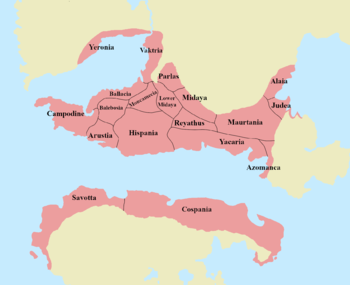Difference between revisions of "Romanyan Empire"
| Line 92: | Line 92: | ||
* [[Romanyan Dastivia|Dastivia]] 325 - 515 CE | * [[Romanyan Dastivia|Dastivia]] 325 - 515 CE | ||
* [[Romanyan Ballacia|Ballacia]] 35 BC - 636 AD | * [[Romanyan Ballacia|Ballacia]] 35 BC - 636 AD | ||
| − | * [[Savotta (Romanyan province)| | + | * [[Savotta (Romanyan province)|Savotta]] 35 BC - 680 AD (continued with the [[Savottan Empire]]) |
=== Client States === | === Client States === | ||
Revision as of 07:46, 2 April 2024
Romanyan Empire Imperium Romanum | |||||||||||||||||||
|---|---|---|---|---|---|---|---|---|---|---|---|---|---|---|---|---|---|---|---|
| 35 BC–AD 680 (unified) AD 680–1350 (Savottan Empire) | |||||||||||||||||||
Imperial aquila
| |||||||||||||||||||
 | |||||||||||||||||||
| Capital | Romanya | ||||||||||||||||||
| Common languages | Ayreoshubic, Romanyan Iberic | ||||||||||||||||||
| Religion | Romanyan Paganism, Romanyan Christianity | ||||||||||||||||||
| Demonym(s) | Romanyan | ||||||||||||||||||
| Government | Semi-elective, functionally absolute monarchy. | ||||||||||||||||||
| Emperor | |||||||||||||||||||
| Historical era | Ancient | ||||||||||||||||||
• Empire Established | 35 BC | ||||||||||||||||||
• Fall of Romanya | 680 AD | ||||||||||||||||||
| 1350 AD | |||||||||||||||||||
| Population | |||||||||||||||||||
• 25 BC | 56,800,000 | ||||||||||||||||||
| Currency | Sestertius, Denarius, Aureus, Solidus | ||||||||||||||||||
| |||||||||||||||||||
| Today part of | Template:Country data Leorkhin Template:Country data Poldasar | ||||||||||||||||||
The Romanyan Empire (Romanyan Iberic: Imperium Romanum) was the post-Republican period of Ancient Romanya. As a polity, it was one of the largest nations ever in Terraconservan history which consisted of large territorial holdings in southern Ecros and northern Sur, mainly around the Alzanub Sea, which were ruled by emperors. From the first emperor to the anarchy of the third century, the empire was ruled by a single emperor who governed from the city of Romanya. Later, the empire was ruled by multiple emperors who shared control over the Northern Romanyan Empire and the Southern Romanyan Empire. The adoption of Christianity as the state religion of the empire and the fall of the Northern Empire to Muslim conquerors conventionally marks the end of classical antiquity and the beginning of the Middle Ages.
Contents
History
Transition from Republic to Empire
Romanyan Expansion
Fall of Romanya and survival in the South
Geography and demography
Provinces
- Alaia 35 BC - 630 AD
- Vaktria 130 - 325 AD
- Dastivia 325 - 515 CE
- Ballacia 35 BC - 636 AD
- Savotta 35 BC - 680 AD (continued with the Savottan Empire)
Client States
- Craeperia Citerior 110 - 193 AD

